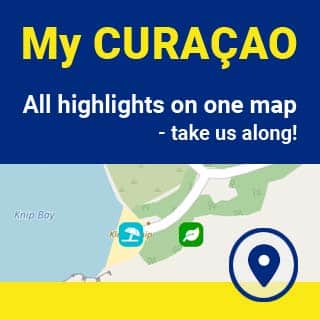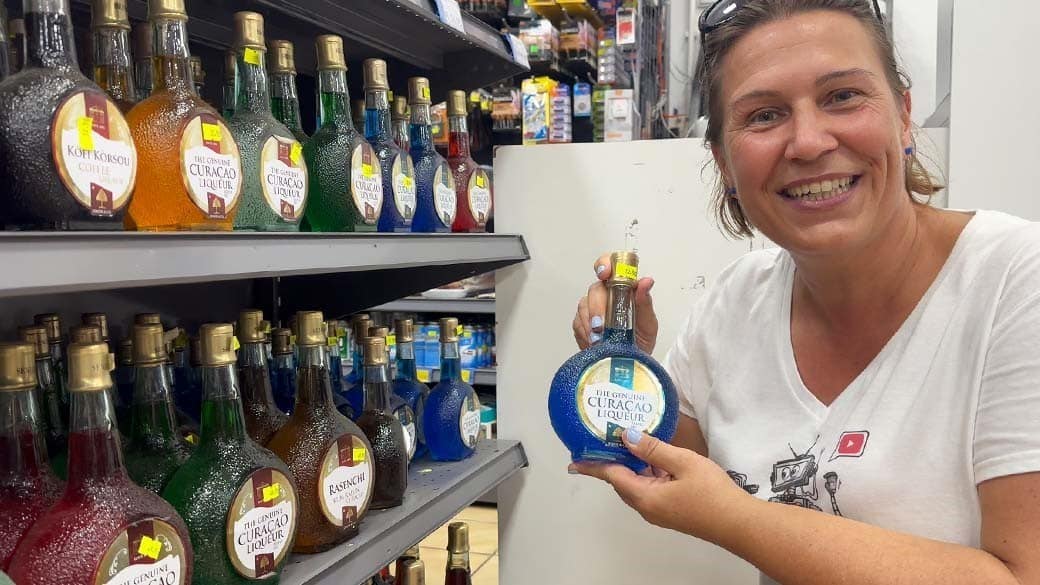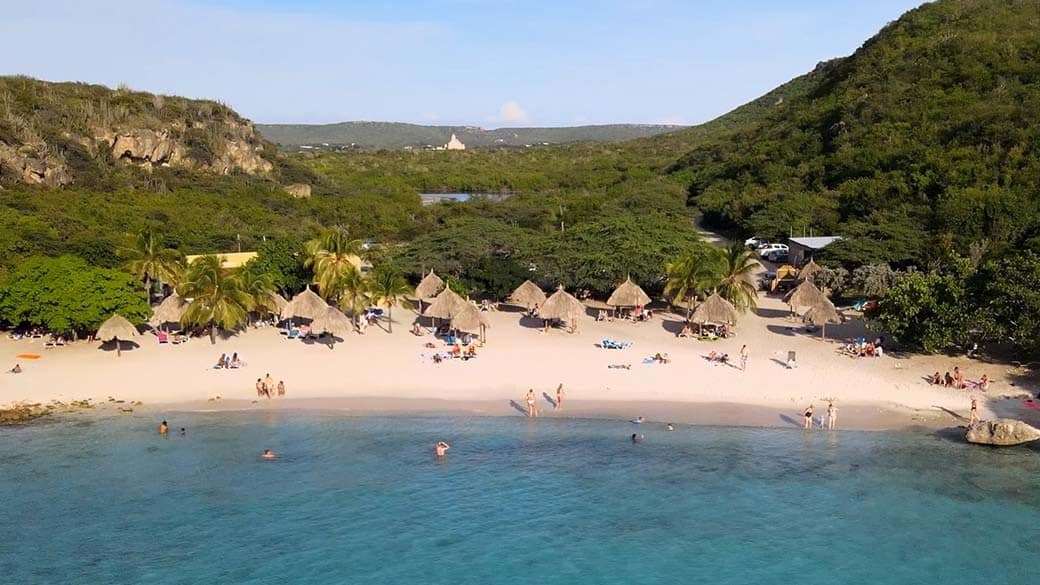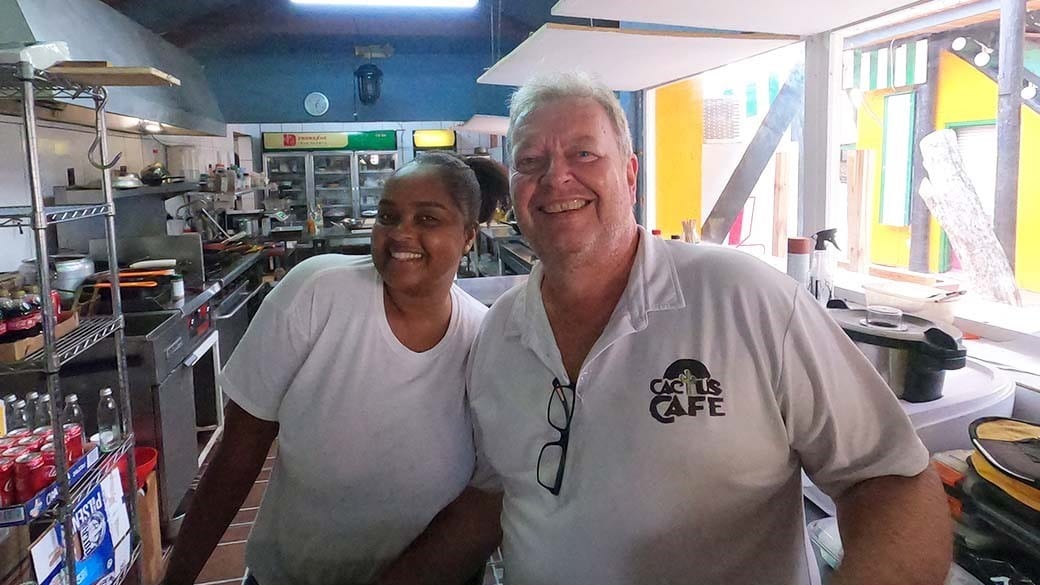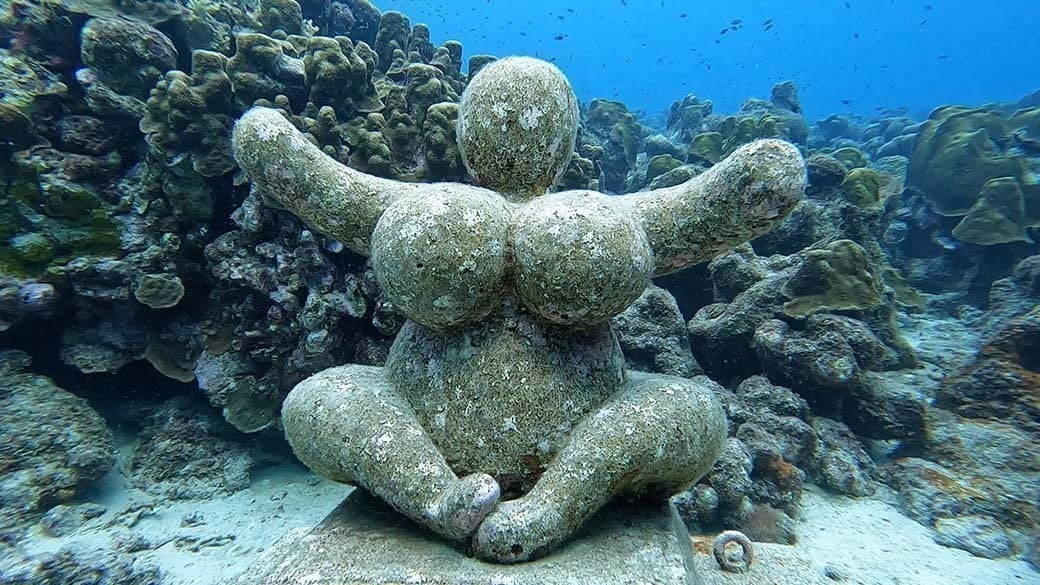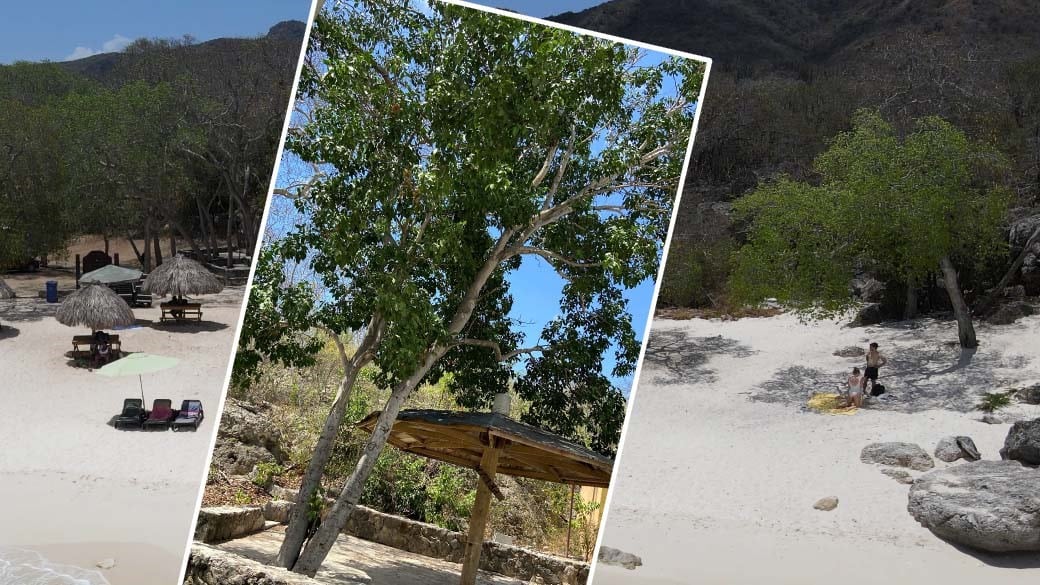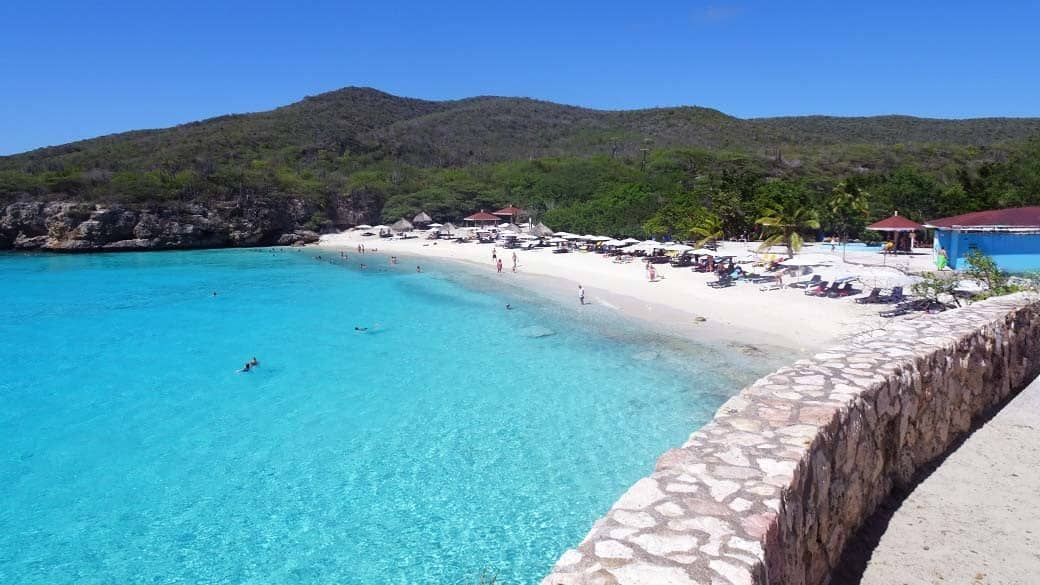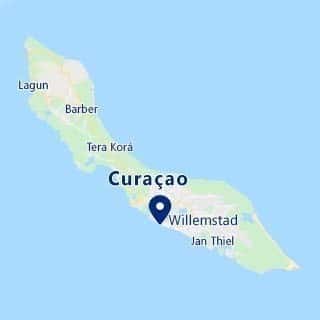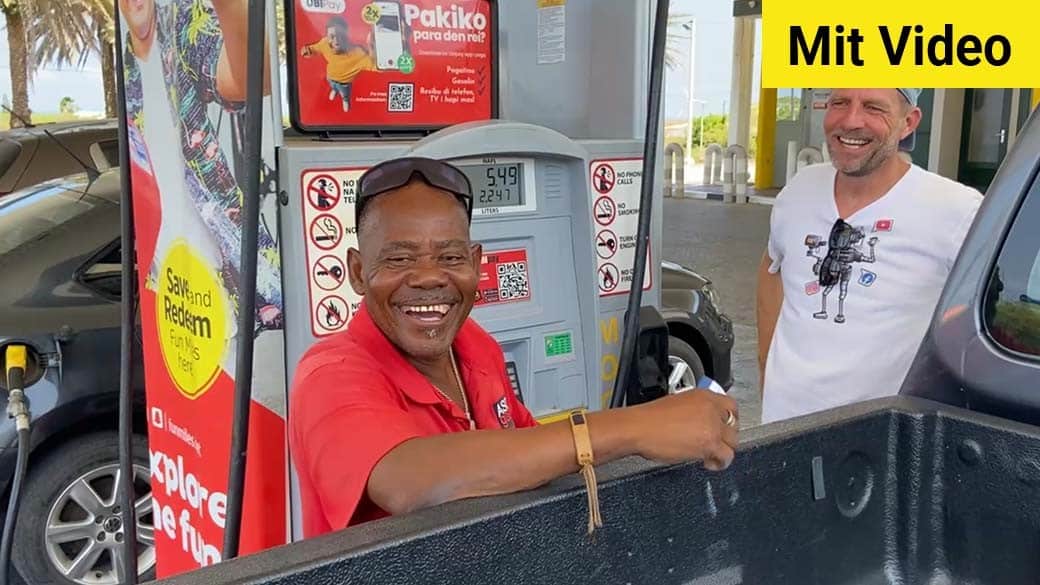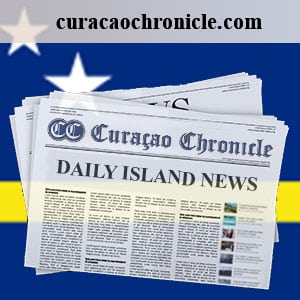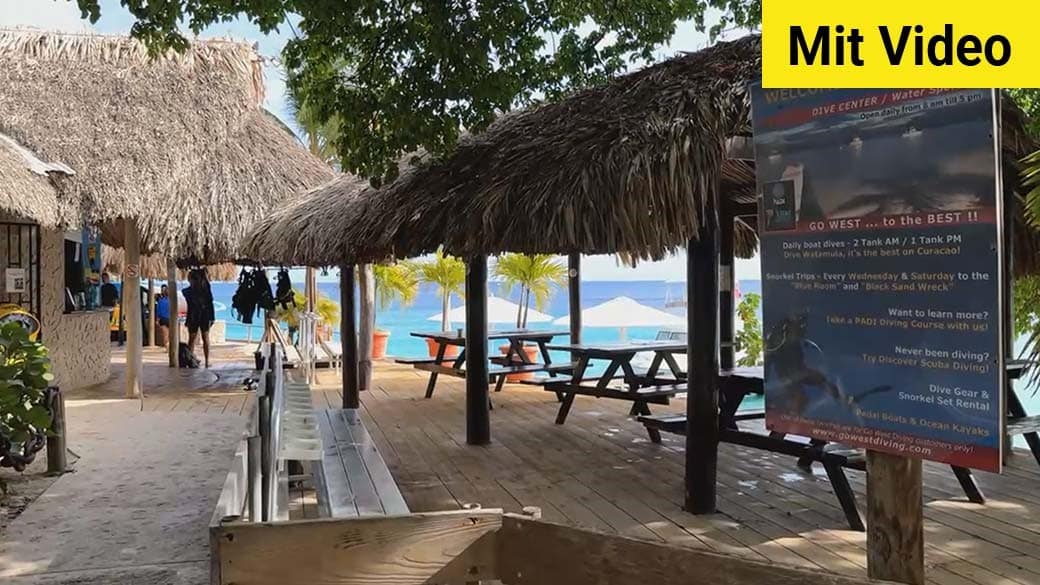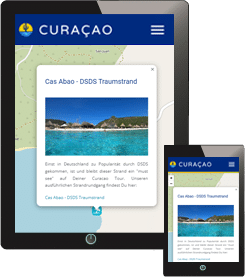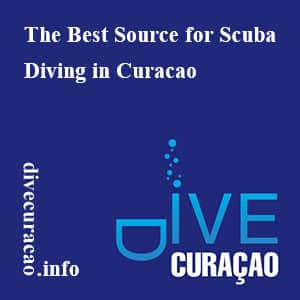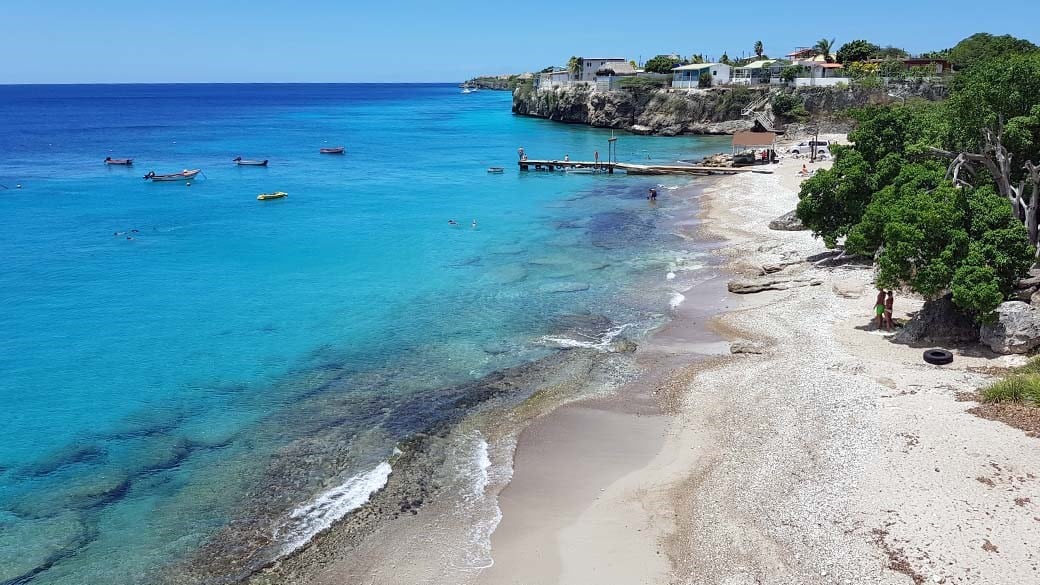Kas di Piskadó Purunchi
Insider tip for eating fresh fish in Curacao
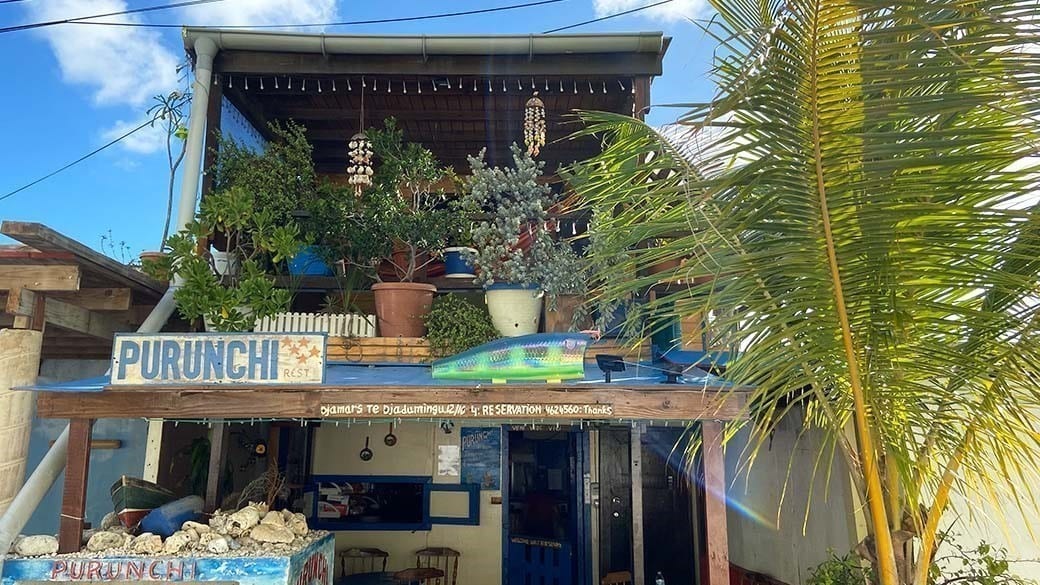
Kas di Piskado Purunchi is no ordinary fish restaurant. “Kas di Piskadó” is Papiamentu and translates as “fisherman’s house”. And that’s exactly what it is. It stands in the middle of a row of other fishermen’s houses right on the shore. The only difference is that it’s open to hungry visitors.

View along the fishermen’s cottages towards the east
Always along the wall
We’re not far from the stylish “Corendon Mangrove Beach Resort – Curio by Hilton” on John F. Kennedy Boulevard in the Mundo Nobo district. Looking back, we can see cruise ships from behind – still huge, even though they are moored a good distance away on the Mega Pier. We pass the large, green tanks of the Aqualectra Power Plant, which supplies the island with drinking water.
So, where is the fisherman’s house? Well, we drove past it first of all. 😮 Then we saw a balcony decorated with potted plants and wind chimes. It was only at second glance that we spotted the PURUNCHI sign. The hull of a parrotfish next to it reveals what is hidden behind the façade: what we consider to be the best fish restaurant on Curacao.
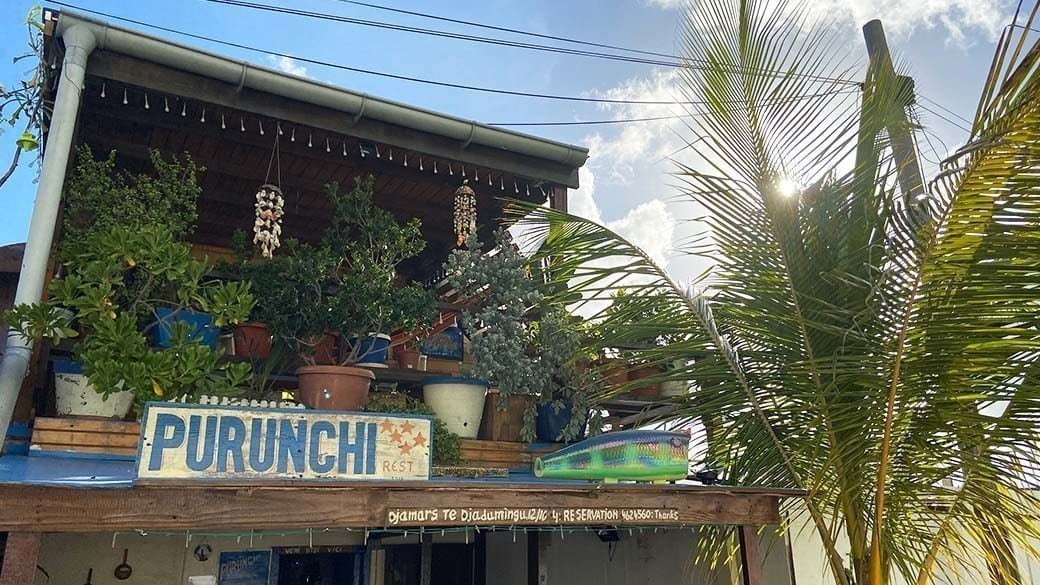
Someone with a green thumb lives here
Zakitó
You can park right there on the wall of the Zakitó running and walking path. Well-known artists like Sander van Beusekom have left their mark with murals that stretch almost a kilometer. Rating: worth a visit!
If you are a passionate jogger, then the 4.7 km long Zakitó is the right place for you. It stretches all the way to Piscadera and is pretty easy to run. You’ll have to decide whether it’s really that easy at over 30° C. You can’t walk in the shade, but you do have a great view of the sea. A big part of the path leads you along the waterfront.

Water storage tanks of the seawater desalination plant
Now, let’s talk about cooking.
From fisherman’s house to restaurant
The story of Purunchi began with an after-work beer and guitar music from the fisherman’s family at the house. Over time, more and more people joined them. At some point, there was also something to eat – fish, of course. It became a regular thing and the ordinary fisherman’s house turned into a restaurant. The family still lives in the house today.

Fishing boats next to Kas di Piskadó Purunchi
A warm welcome
If no one greets you at the door, you will be called in with a friendly “Bonbini na Purunchi” (= Welcome to Purunchi). For us it was Gina and when she said Purunchi, she stretched out the second “u”: Puruuuuunchi. It sounds funny and it’s fun to do the same. You know, everybody who has already been there, stretches the u like that – a kind of insider communication. We love it!
Of course, we don’t speak Papiamentu, but with hands and feet and linguistic gibberish, communication worked out somehow. It really got going when Jai was called down from above, as he speaks very good English. We felt like we were at a friend’s house, only with a good portion of fish on the plate.
Authentic flair
The way deeper into Purunchi is straight through the kitchen. There’s nothing to hide here and you can watch the food being prepared. The rustic ambience with light wooden furniture gives the place a homely atmosphere. It’s not about who has the best tablecloth, but about serving the best fish and having a good time.

View from the dock into the restaurant
Floating dock
As a guest, you can either sit in the boathouse, which is open to the front, or on the iconic floating dock. A small wooden hut is connected to the main house by a mini jetty. The creaking wood, rocking hut, and gurgling water create a special effect. “Sittin on the dock of the bay” by Otis Redding sends its regards. We almost got a little sleepy after dinner…
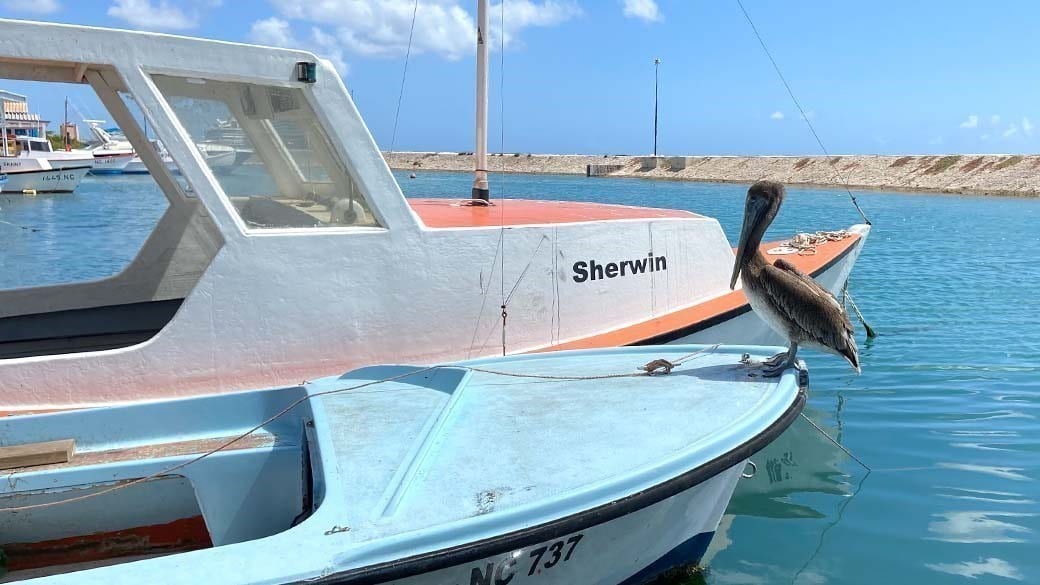
Eye to eye with a pelican
Good prospects
The fish you can see at the bottom of the shallow water are close enough to touch. While you wait for the fish together with pelicans 😅, they watch the action from the boats next door. My goodness, they are really big up close! The bird show comes free with lunch, so to speak. Don’t worry, the pelicans won’t steal the fish from your plate. The window flaps from above keep them at a distance.

You can catch a glimpse of the bay between the dock and the main house
Fresh, fresher, Purunchi!
The menu is simple. There’s only one main course, the “Catch of the Day”. The fish is so fresh that it’s still splashing around. There are no middlemen or long transportation routes. Several fishermen make short trips during the day and deliver the fish here – straight into the pan. In our case, it was lionfish. Stefan was told by the chef that it has to be fried for longer than other fish.

Lionfish sizzling in the pan
Because the staff don’t know what they’ll catch the next day, it’s always a surprise for the guests until they place their order. We were delighted with our Catch of the Day because we love Lionfish. Only the side dishes are fixed from the outset. I’d highly recommend the fried plantain: banana èkstra. This also costs extra, but is extra tasty. But the food at Purunchi is pretty affordable. For about 15 euros, you can get the catch of the day, with a choice of fresh salad, funchi or tutu.

Freshly fried lionfish with side dishes
Five stars for the Kas di Piskadó Purunchi
Purunchi isn’t a Michelin-starred restaurant, but the fish here is really good. It’s paired with a pinch of local lifestyle. Do as the islanders do and be a guest in the fisherman’s house.
Purunchi gets 5 stars from us. It looks like they knew this already when they painted their nameplate, with five yellow stars next to the blue letters. 😉 As a small tribute, we have made a short video about our visit to Purunchi:
Hours: Open every day except Monday from 12 pm to 4 pm. Due to high demand and limited seating, you should make a reservation. If you’re in a hurry or prefer to eat at home, curbside pickup is available.
Tip for divers: You might want to consider combining a morning dive with lunch afterwards at Purunchi.
Double Reef diving spot
There’s a popular dive site nearby, the Double Reef. It’s located just before the mouth of the mangroves – at the level of the “Parke Lucha par Libertat” (= park for the fight for freedom).
Within the park, there’s a monument to Tula, which symbolically shows slaves breaking their chains, a memorial in the form of a white fist with a chain directly in front of the sea and a yellow semicircle commemorating all martyrs in the fight for freedom. The slave Tula was the leader of the slave revolt that started from the Kenepa country house. Today, the plantation house in the west of the island houses the Museo Tula, a historical museum on the island’s slavery past.
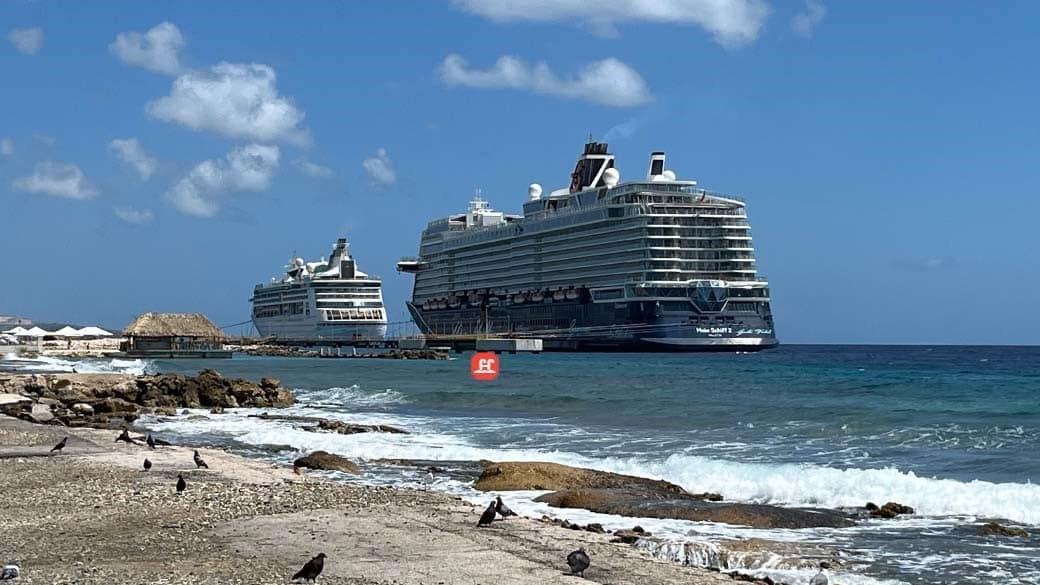
The red icon shows the approximate location of the Double Reef
Our partner Bryan Horne, has diving info about the Double Reef for you. Here are some first impressions of the underwater world on video:
Do you know the answer? We collected 100+ entertaining questions about Curacao. Have fun!
Quiz Question
Is there a rooftop bar in Curacao?Answer
Yes, in Willemstad, in the Punda district, directly on Wilhelminaplein.
The Rooftopbar Cascada is located on the roof terrace of the Elements Hotel and offers a 360° view over the city and out to sea.
Click here for our YouTube video about the Cascada rooftop bar.
Do you like more? Here is another post you might be interested in:
Maybe you've seen one of our ads for the American Express Platinum Card. If so, you might be wondering why we advertise on o...
If you enjoyed this article, we would be very happy if you share it with your friends on social media. Thank you very much!
Planning your next vacation day? Join us on an exploration tour and take a closer look at our other sections. Whether it’s beaches, nature, shopping or lifestyle – there’s much more to discover! We have bundled tips for your relaxed and comfortable trip to your vacation paradise in our Relaxed Travelling section.
When you hear the name of the island of Curacao, the first thing that usually comes to mind is Blue Curacao. You probably kn...
One of the most common questions asked in the Curacao forums is "Where should I rent a car?" Is there the best car rental co...
At the eye catching and remarkable peach-colored church of Sint Willibrordus turn sharp left. Drive over the three hillocks a...
Kas di Piskadó Purunchi
Insider tip for eating fresh fish in Curacao

Kas di Piskado Purunchi is no ordinary fish restaurant. “Kas di Piskadó” is Papiamentu and translates as “fisherman’s house”. And that’s exactly what it is. It stands in the middle of a row of other fishermen’s houses right on the shore. The only difference is that it’s open to hungry visitors.

View along the fishermen’s cottages towards the east
Always along the wall
We’re not far from the stylish “Corendon Mangrove Beach Resort – Curio by Hilton” on John F. Kennedy Boulevard in the Mundo Nobo district. Looking back, we can see cruise ships from behind – still huge, even though they are moored a good distance away on the Mega Pier. We pass the large, green tanks of the Aqualectra Power Plant, which supplies the island with drinking water.
So, where is the fisherman’s house? Well, we drove past it first of all. 😮 Then we saw a balcony decorated with potted plants and wind chimes. It was only at second glance that we spotted the PURUNCHI sign. The hull of a parrotfish next to it reveals what is hidden behind the façade: what we consider to be the best fish restaurant on Curacao.

Someone with a green thumb lives here
Zakitó
You can park right there on the wall of the Zakitó running and walking path. Well-known artists like Sander van Beusekom have left their mark with murals that stretch almost a kilometer. Rating: worth a visit!
If you are a passionate jogger, then the 4.7 km long Zakitó is the right place for you. It stretches all the way to Piscadera and is pretty easy to run. You’ll have to decide whether it’s really that easy at over 30° C. You can’t walk in the shade, but you do have a great view of the sea. A big part of the path leads you along the waterfront.

Water storage tanks of the seawater desalination plant
Now, let’s talk about cooking.
From fisherman’s house to restaurant
The story of Purunchi began with an after-work beer and guitar music from the fisherman’s family at the house. Over time, more and more people joined them. At some point, there was also something to eat – fish, of course. It became a regular thing and the ordinary fisherman’s house turned into a restaurant. The family still lives in the house today.

Fishing boats next to Kas di Piskadó Purunchi
A warm welcome
If no one greets you at the door, you will be called in with a friendly “Bonbini na Purunchi” (= Welcome to Purunchi). For us it was Gina and when she said Purunchi, she stretched out the second “u”: Puruuuuunchi. It sounds funny and it’s fun to do the same. You know, everybody who has already been there, stretches the u like that – a kind of insider communication. We love it!
Of course, we don’t speak Papiamentu, but with hands and feet and linguistic gibberish, communication worked out somehow. It really got going when Jai was called down from above, as he speaks very good English. We felt like we were at a friend’s house, only with a good portion of fish on the plate.
Authentic flair
The way deeper into Purunchi is straight through the kitchen. There’s nothing to hide here and you can watch the food being prepared. The rustic ambience with light wooden furniture gives the place a homely atmosphere. It’s not about who has the best tablecloth, but about serving the best fish and having a good time.

View from the dock into the restaurant
Floating dock
As a guest, you can either sit in the boathouse, which is open to the front, or on the iconic floating dock. A small wooden hut is connected to the main house by a mini jetty. The creaking wood, rocking hut, and gurgling water create a special effect. “Sittin on the dock of the bay” by Otis Redding sends its regards. We almost got a little sleepy after dinner…

Eye to eye with a pelican
Good prospects
The fish you can see at the bottom of the shallow water are close enough to touch. While you wait for the fish together with pelicans 😅, they watch the action from the boats next door. My goodness, they are really big up close! The bird show comes free with lunch, so to speak. Don’t worry, the pelicans won’t steal the fish from your plate. The window flaps from above keep them at a distance.

You can catch a glimpse of the bay between the dock and the main house
Fresh, fresher, Purunchi!
The menu is simple. There’s only one main course, the “Catch of the Day”. The fish is so fresh that it’s still splashing around. There are no middlemen or long transportation routes. Several fishermen make short trips during the day and deliver the fish here – straight into the pan. In our case, it was lionfish. Stefan was told by the chef that it has to be fried for longer than other fish.

Lionfish sizzling in the pan
Because the staff don’t know what they’ll catch the next day, it’s always a surprise for the guests until they place their order. We were delighted with our Catch of the Day because we love Lionfish. Only the side dishes are fixed from the outset. I’d highly recommend the fried plantain: banana èkstra. This also costs extra, but is extra tasty. But the food at Purunchi is pretty affordable. For about 15 euros, you can get the catch of the day, with a choice of fresh salad, funchi or tutu.

Freshly fried lionfish with side dishes
Five stars for the Kas di Piskadó Purunchi
Purunchi isn’t a Michelin-starred restaurant, but the fish here is really good. It’s paired with a pinch of local lifestyle. Do as the islanders do and be a guest in the fisherman’s house.
Purunchi gets 5 stars from us. It looks like they knew this already when they painted their nameplate, with five yellow stars next to the blue letters. 😉 As a small tribute, we have made a short video about our visit to Purunchi:
Hours: Open every day except Monday from 12 pm to 4 pm. Due to high demand and limited seating, you should make a reservation. If you’re in a hurry or prefer to eat at home, curbside pickup is available.
Tip for divers: You might want to consider combining a morning dive with lunch afterwards at Purunchi.
Double Reef diving spot
There’s a popular dive site nearby, the Double Reef. It’s located just before the mouth of the mangroves – at the level of the “Parke Lucha par Libertat” (= park for the fight for freedom).
Within the park, there’s a monument to Tula, which symbolically shows slaves breaking their chains, a memorial in the form of a white fist with a chain directly in front of the sea and a yellow semicircle commemorating all martyrs in the fight for freedom. The slave Tula was the leader of the slave revolt that started from the Kenepa country house. Today, the plantation house in the west of the island houses the Museo Tula, a historical museum on the island’s slavery past.

The red icon shows the approximate location of the Double Reef
Our partner Bryan Horne, has diving info about the Double Reef for you. Here are some first impressions of the underwater world on video:
Other articles from the “Bars & Restaurants” category that might interest you:
If you enjoyed this article, we would be very happy if you share it with your friends on social media. Thank you very much!
Leave A Comment Cancel reply
Recommended readings from other categories:
Alice in Wonderland is one of Curacao's most famous dive sites. It is accessible directly from Playa Kalki in the island's f...
I set out to learn where the name of the Kenepa beaches, Grandi and Chiki (also known as Big and Little Knip), came from. My...
The beach Kenepa Grandi, or Grote Knip, is located just behind the little village Lagun in the west of Curacao. A lot of the ...
At the eye catching and remarkable peach-colored church of Sint Willibrordus turn sharp left. Drive over the three hillocks a...
Fueling up in Curacao works according to the prepaid model, which is a little different than in Europe. In our video and in ...
Quiz Question
Is there a rooftop bar in Curacao?Answer
Yes, in Willemstad, in the Punda district, directly on Wilhelminaplein.
The Rooftopbar Cascada is located on the roof terrace of the Elements Hotel and offers a 360° view over the city and out to sea.
Click here for our YouTube video about the Cascada rooftop bar.
Playa Kalki beach in Westpunt is home to one of the best dive centers on Curacao: Go West Diving. The reef at Playa Kalki is...
One of the most common questions asked in the Curacao forums is "Where should I rent a car?" Is there the best car rental co...
#withus - our articles at your fingertips on a common map - try it!
We've all been there: you're somewhere in the world and you need, want, or are allowed to bring a souvenir back to your love...
Kas di Piskadó Purunchi
Insider tip for eating fresh fish in Curacao

Kas di Piskado Purunchi is no ordinary fish restaurant. “Kas di Piskadó” is Papiamentu and translates as “fisherman’s house”. And that’s exactly what it is. It stands in the middle of a row of other fishermen’s houses right on the shore. The only difference is that it’s open to hungry visitors.

View along the fishermen’s cottages towards the east
Always along the wall
We’re not far from the stylish “Corendon Mangrove Beach Resort – Curio by Hilton” on John F. Kennedy Boulevard in the Mundo Nobo district. Looking back, we can see cruise ships from behind – still huge, even though they are moored a good distance away on the Mega Pier. We pass the large, green tanks of the Aqualectra Power Plant, which supplies the island with drinking water.
So, where is the fisherman’s house? Well, we drove past it first of all. 😮 Then we saw a balcony decorated with potted plants and wind chimes. It was only at second glance that we spotted the PURUNCHI sign. The hull of a parrotfish next to it reveals what is hidden behind the façade: what we consider to be the best fish restaurant on Curacao.

Someone with a green thumb lives here
Zakitó
You can park right there on the wall of the Zakitó running and walking path. Well-known artists like Sander van Beusekom have left their mark with murals that stretch almost a kilometer. Rating: worth a visit!
If you are a passionate jogger, then the 4.7 km long Zakitó is the right place for you. It stretches all the way to Piscadera and is pretty easy to run. You’ll have to decide whether it’s really that easy at over 30° C. You can’t walk in the shade, but you do have a great view of the sea. A big part of the path leads you along the waterfront.

Water storage tanks of the seawater desalination plant
Now, let’s talk about cooking.
From fisherman’s house to restaurant
The story of Purunchi began with an after-work beer and guitar music from the fisherman’s family at the house. Over time, more and more people joined them. At some point, there was also something to eat – fish, of course. It became a regular thing and the ordinary fisherman’s house turned into a restaurant. The family still lives in the house today.

Fishing boats next to Kas di Piskadó Purunchi
A warm welcome
If no one greets you at the door, you will be called in with a friendly “Bonbini na Purunchi” (= Welcome to Purunchi). For us it was Gina and when she said Purunchi, she stretched out the second “u”: Puruuuuunchi. It sounds funny and it’s fun to do the same. You know, everybody who has already been there, stretches the u like that – a kind of insider communication. We love it!
Of course, we don’t speak Papiamentu, but with hands and feet and linguistic gibberish, communication worked out somehow. It really got going when Jai was called down from above, as he speaks very good English. We felt like we were at a friend’s house, only with a good portion of fish on the plate.
Authentic flair
The way deeper into Purunchi is straight through the kitchen. There’s nothing to hide here and you can watch the food being prepared. The rustic ambience with light wooden furniture gives the place a homely atmosphere. It’s not about who has the best tablecloth, but about serving the best fish and having a good time.

View from the dock into the restaurant
Floating dock
As a guest, you can either sit in the boathouse, which is open to the front, or on the iconic floating dock. A small wooden hut is connected to the main house by a mini jetty. The creaking wood, rocking hut, and gurgling water create a special effect. “Sittin on the dock of the bay” by Otis Redding sends its regards. We almost got a little sleepy after dinner…

Eye to eye with a pelican
Good prospects
The fish you can see at the bottom of the shallow water are close enough to touch. While you wait for the fish together with pelicans 😅, they watch the action from the boats next door. My goodness, they are really big up close! The bird show comes free with lunch, so to speak. Don’t worry, the pelicans won’t steal the fish from your plate. The window flaps from above keep them at a distance.

You can catch a glimpse of the bay between the dock and the main house
Fresh, fresher, Purunchi!
The menu is simple. There’s only one main course, the “Catch of the Day”. The fish is so fresh that it’s still splashing around. There are no middlemen or long transportation routes. Several fishermen make short trips during the day and deliver the fish here – straight into the pan. In our case, it was lionfish. Stefan was told by the chef that it has to be fried for longer than other fish.

Lionfish sizzling in the pan
Because the staff don’t know what they’ll catch the next day, it’s always a surprise for the guests until they place their order. We were delighted with our Catch of the Day because we love Lionfish. Only the side dishes are fixed from the outset. I’d highly recommend the fried plantain: banana èkstra. This also costs extra, but is extra tasty. But the food at Purunchi is pretty affordable. For about 15 euros, you can get the catch of the day, with a choice of fresh salad, funchi or tutu.

Freshly fried lionfish with side dishes
Five stars for the Kas di Piskadó Purunchi
Purunchi isn’t a Michelin-starred restaurant, but the fish here is really good. It’s paired with a pinch of local lifestyle. Do as the islanders do and be a guest in the fisherman’s house.
Purunchi gets 5 stars from us. It looks like they knew this already when they painted their nameplate, with five yellow stars next to the blue letters. 😉 As a small tribute, we have made a short video about our visit to Purunchi:
Hours: Open every day except Monday from 12 pm to 4 pm. Due to high demand and limited seating, you should make a reservation. If you’re in a hurry or prefer to eat at home, curbside pickup is available.
Tip for divers: You might want to consider combining a morning dive with lunch afterwards at Purunchi.
Double Reef diving spot
There’s a popular dive site nearby, the Double Reef. It’s located just before the mouth of the mangroves – at the level of the “Parke Lucha par Libertat” (= park for the fight for freedom).
Within the park, there’s a monument to Tula, which symbolically shows slaves breaking their chains, a memorial in the form of a white fist with a chain directly in front of the sea and a yellow semicircle commemorating all martyrs in the fight for freedom. The slave Tula was the leader of the slave revolt that started from the Kenepa country house. Today, the plantation house in the west of the island houses the Museo Tula, a historical museum on the island’s slavery past.

The red icon shows the approximate location of the Double Reef
Our partner Bryan Horne, has diving info about the Double Reef for you. Here are some first impressions of the underwater world on video:
Other articles we recommend for you:
If you're looking for Caribbean specialties (like stobas) or island classics (like spare ribs), the Cactus Café in Westpunt ...
Kas di Piskado Purunchi is no ordinary fish restaurant. "Kas di Piskadó" is Papiamentu and translates as "fisherman's house"...
Alice in Wonderland is one of Curacao's most famous dive sites. It is accessible directly from Playa Kalki in the island's f...
Curacao is alive and things are always changing. What has changed since our last visit? How is your experience? Would you please share your personal experiences with us? Feel free to write your comment under this article and follow us on our social media channels. There you can spontaneously share your personal impressions with us and our community - "sharing is caring". We look forward to your contribution and every new follower!
Leave A Comment Cancel reply
When you hear the name of the island of Curacao, the first thing that usually comes to mind is Blue Curacao. You probably kn...
Quiz Question
Is there a rooftop bar in Curacao?Answer
Yes, in Willemstad, in the Punda district, directly on Wilhelminaplein.
The Rooftopbar Cascada is located on the roof terrace of the Elements Hotel and offers a 360° view over the city and out to sea.
Click here for our YouTube video about the Cascada rooftop bar.
It’s definitely worth checking out the west corner of Curacao because it’s where you can see some turtles for sure. You don’t...
Playa Kalki beach in Westpunt is home to one of the best dive centers on Curacao: Go West Diving. The reef at Playa Kalki is...
#withus - our articles at your fingertips on a common map - try it!
The beach Kenepa Grandi, or Grote Knip, is located just behind the little village Lagun in the west of Curacao. A lot of the ...












